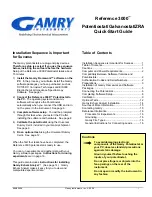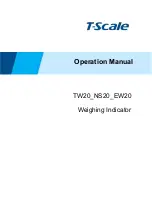
500-62201-001 Rev. M
Page 24 of 33
Determining Specific Gravity
The L622 calibration is based on an equation that relates
measurement correction to the specific gravity of a given
species. Species of wood in different regions may have
a specific gravity that differs from that which is published
in wood drying handbooks. If you do not know the
species of the wood you are using, or the specific gravity
differs from the handbook because of a different growing
region, then use the following procedure for determining
specific gravity.
1. Select a sample of wood with all edges being true.
Carefully measure the dimensions of your sample
using a caliper. You will need the length, width, and
thickness.
2. Convert these measurements into feet or meters (ft.
or m).
3. Carefully measure the weight of your sample.
4. Convert the weight to pounds or kilograms (lb. or kg).
5. Calculate specific gravity (SG).
An English units illustration:
Length: 10 in. converted to feet is 10 in./ 12 = 0.833 ft.
Width: 7.5 in. converted to feet is 7.5 in. / 12 = 0.625 ft.
Thickness: 1.5 in. converted to feet is 1.5 in./ 12 = 0.125 ft.
Weight: 20 oz. converted to lb. is 20 oz. / 16 = 1.25 lb.
Volume: L x W x T: 0.833 x 0.625 x 0.125 = 0.065 ft
3
.
SG = (Weight / Volume) / Density of Water
SG = (1.25 lb. / 0.065 ft
3
) / 62.34 lb./ ft
3
= 0.31
A metric units illustration:
Length: 254 mm converted to meters is = 0.254 m.
Width: 190 mm converted to meters is = 0.190 m.
Thickness: 38 mm converted to meters is = 0.038 m.
Mass: 565 converted to kg is = 0.565 kg.
Volume: L x W x T: 0. 254 x 0. 190 x 0. 038 = 0.00183 m
3
.
SG = (Mass / Volume) / Density of Water
SG = (0.565 kg / 0.00183 m
3
) / 1000 kg/m
3
= 0.31
In order to ensure that the value obtained for the specific
gravity is statistically significant, a number of pieces must
be measured and the average determined. Use this
value of specific gravity for your species of wood.










































